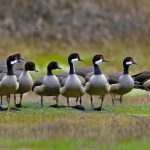Geese are fascinating creatures with complex behaviors that can be both beautiful and challenging. Understanding their behavior is crucial in finding effective ways to manage their presence in certain areas. Geese are social animals that often travel in flocks, and they are known for their strong family bonds. They are also highly territorial and can become aggressive when they feel threatened or when their nesting sites are disturbed. Geese are also attracted to areas with abundant food sources, open spaces, and bodies of water, making these areas prime locations for them to gather and potentially cause problems for humans.
Geese are also known for their strong homing instincts, which means that once they have found a suitable location, they are likely to return to it year after year. This can make managing their presence a long-term challenge. Additionally, geese are highly adaptable and can quickly learn to overcome deterrents that are not consistently maintained or changed. Understanding these behaviors is essential in developing effective strategies for managing geese and preventing conflicts with humans.
Geese are also known for their strong homing instincts, which means that once they have found a suitable location, they are likely to return to it year after year. This can make managing their presence a long-term challenge. Additionally, geese are highly adaptable and can quickly learn to overcome deterrents that are not consistently maintained or changed. Understanding these behaviors is essential in developing effective strategies for managing geese and preventing conflicts with humans.
Key Takeaways
- Geese are territorial and can become aggressive during nesting season
- Physical barriers like fences and netting can prevent geese from accessing certain areas
- Visual deterrents like decoys and predator silhouettes can scare geese away
- Sound deterrents like ultrasonic devices can disrupt geese communication and drive them away
- Repellents like taste aversions and chemical deterrents can discourage geese from staying in an area
- Keeping landscapes unattractive to geese by removing food sources and modifying habitats
- Professional help from wildlife experts can provide effective and humane solutions for managing geese populations
Implementing Physical Barriers
One effective way to manage the presence of geese in a specific area is by implementing physical barriers. These barriers can include fencing, netting, or other structures that prevent geese from accessing certain areas. Fencing can be particularly effective in keeping geese away from sensitive areas such as parks, golf courses, and agricultural fields. It is important to ensure that the fencing is tall enough to prevent geese from flying over it and that it extends into the ground to prevent them from digging underneath it.
Netting can also be used to cover bodies of water, preventing geese from accessing them for feeding or resting. This can be particularly useful in areas where geese are causing damage to water bodies or where their presence poses a risk to human health and safety. It is important to regularly inspect and maintain physical barriers to ensure their effectiveness, as geese can quickly adapt and find ways to overcome them if they are not properly maintained.
In addition to fencing and netting, other physical barriers such as hazing devices and visual deterrents can also be effective in managing the presence of geese in certain areas. These devices can create an unwelcoming environment for geese, discouraging them from staying in the area. By implementing physical barriers, it is possible to effectively manage the presence of geese and prevent conflicts with humans.
Using Visual Deterrents
Visual deterrents can be an effective way to manage the presence of geese in certain areas. These deterrents work by creating an environment that is unappealing or threatening to geese, encouraging them to move on to more suitable locations. One common visual deterrent is the use of predator decoys, such as fake coyotes or birds of prey, which can create the illusion of danger for geese and discourage them from staying in the area.
Another visual deterrent that can be effective is the use of reflective objects, such as tape or balloons, which can create a disorienting and intimidating environment for geese. These objects can be placed strategically in areas where geese tend to gather, such as around bodies of water or open fields, to discourage them from staying in the area. It is important to regularly move and change the placement of visual deterrents to prevent geese from becoming accustomed to them.
In addition to predator decoys and reflective objects, other visual deterrents such as scarecrows and motion-activated devices can also be effective in managing the presence of geese in certain areas. By using visual deterrents, it is possible to create an environment that is unappealing to geese and encourage them to move on to more suitable locations.
Installing Sound Deterrents
Sound deterrents can be an effective way to manage the presence of geese in certain areas. These deterrents work by emitting loud noises or distress calls that create an unwelcoming environment for geese, encouraging them to move on to more suitable locations. One common sound deterrent is the use of propane cannons, which emit loud bangs at regular intervals to create a sense of danger for geese and discourage them from staying in the area.
Another sound deterrent that can be effective is the use of distress calls or recordings of predator calls, which can create a sense of danger and encourage geese to move on to more suitable locations. These calls can be played at regular intervals in areas where geese tend to gather, such as around bodies of water or open fields, to discourage them from staying in the area. It is important to regularly change the type and timing of sound deterrents to prevent geese from becoming accustomed to them.
In addition to propane cannons and distress calls, other sound deterrents such as ultrasonic devices and bird distress alarm systems can also be effective in managing the presence of geese in certain areas. By using sound deterrents, it is possible to create an environment that is unappealing to geese and encourage them to move on to more suitable locations.
Applying Repellents
Repellents can be an effective way to manage the presence of geese in certain areas. These repellents work by creating an environment that is unappealing or threatening to geese, discouraging them from staying in the area. One common repellent is the use of chemical sprays or granules that create an unpleasant taste or smell for geese, discouraging them from feeding on grass or other vegetation in the area.
Another repellent that can be effective is the use of natural deterrents such as garlic or chili pepper sprays, which can create an unpleasant taste or smell for geese and discourage them from staying in the area. These repellents can be applied to grass, vegetation, or other surfaces where geese tend to gather, such as around bodies of water or open fields, to discourage them from staying in the area. It is important to regularly reapply repellents to ensure their effectiveness, as they can wear off over time.
In addition to chemical sprays and natural deterrents, other repellents such as motion-activated sprinklers and taste aversions can also be effective in managing the presence of geese in certain areas. By applying repellents, it is possible to create an environment that is unappealing to geese and encourage them to move on to more suitable locations.
Creating an Unwelcoming Environment

Creating an unwelcoming environment for geese can be an effective way to manage their presence in certain areas. This can be achieved by making changes to the landscape or modifying existing structures to discourage geese from staying in the area. One common method is the use of landscaping techniques such as planting tall grasses or shrubs around bodies of water or open fields, which can create barriers that make it difficult for geese to access these areas.
Another method for creating an unwelcoming environment is the modification of existing structures such as buildings or fences to prevent geese from roosting or nesting on them. This can include adding spikes or netting to flat surfaces where geese tend to gather, making it uncomfortable or impossible for them to stay in these areas. It is important to regularly inspect and maintain these modifications to ensure their effectiveness, as geese can quickly adapt and find ways to overcome them if they are not properly maintained.
In addition to landscaping techniques and modifications to existing structures, other methods such as habitat management and reducing food sources can also be effective in creating an unwelcoming environment for geese. By creating an environment that is unappealing to geese, it is possible to discourage them from staying in certain areas and prevent conflicts with humans.
Seeking Professional Help
In some cases, managing the presence of geese may require professional assistance. There are companies and organizations that specialize in wildlife management and can provide expertise and resources for effectively managing the presence of geese in certain areas. These professionals can conduct site assessments to identify specific challenges and develop customized management plans tailored to the unique needs of each location.
Professional wildlife management companies can also provide a range of services such as habitat modification, population control measures, and ongoing monitoring and maintenance of deterrents. They have access to specialized equipment and resources that may not be readily available to individuals or organizations without expertise in wildlife management. By seeking professional help, it is possible to effectively manage the presence of geese and prevent conflicts with humans.
In addition to professional wildlife management companies, local government agencies and conservation organizations may also provide assistance and resources for managing the presence of geese in certain areas. These organizations may offer guidance on best practices for managing wildlife conflicts and provide access to funding or grants for implementing management strategies.
In conclusion, managing the presence of geese in certain areas requires a comprehensive understanding of their behavior and the implementation of effective strategies for preventing conflicts with humans. By implementing physical barriers, visual deterrents, sound deterrents, repellents, creating an unwelcoming environment, and seeking professional help when necessary, it is possible to effectively manage the presence of geese and prevent conflicts with humans.
Looking for ways to keep geese off your dock? Check out this insightful article on how many eggs geese lay to understand their behavior better and find effective strategies to deter them from your dock. Understanding the habits of geese can help you implement practical solutions to keep them away from unwanted areas.
FAQs
What are some effective methods to keep geese off a dock?
Some effective methods to keep geese off a dock include installing physical barriers such as netting or fencing, using visual deterrents like scarecrows or reflective tape, and employing sound deterrents such as noise-making devices.
Why is it important to keep geese off a dock?
It is important to keep geese off a dock to prevent damage to the dock structure, reduce the risk of slip and fall accidents caused by goose droppings, and minimize the potential for aggressive behavior from geese towards humans.
Are there any environmentally friendly methods to keep geese off a dock?
Yes, there are environmentally friendly methods to keep geese off a dock, such as using natural repellents like citrus-based sprays or planting vegetation that geese find unappealing.
What should I do if I encounter aggressive geese on a dock?
If you encounter aggressive geese on a dock, it is important to remain calm and slowly back away from the geese. Avoid making direct eye contact and do not attempt to feed or touch the geese. If necessary, seek assistance from a professional wildlife control service.
Are there any legal restrictions on how to keep geese off a dock?
There may be legal restrictions on how to keep geese off a dock, depending on the location and local wildlife regulations. It is important to research and comply with any applicable laws or regulations when implementing methods to deter geese from a dock.
Meet Walter, the feathered-friend fanatic of Florida! Nestled in the sunshine state, Walter struts through life with his feathered companions, clucking his way to happiness. With a coop that’s fancier than a five-star hotel, he’s the Don Juan of the chicken world. When he’s not teaching his hens to do the cha-cha, you’ll find him in a heated debate with his prized rooster, Sir Clucks-a-Lot. Walter’s poultry passion is no yolk; he’s the sunny-side-up guy you never knew you needed in your flock of friends!







